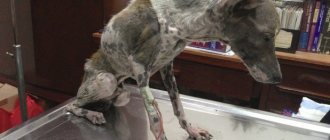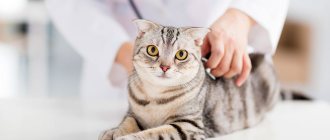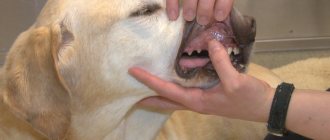Causes
One of the main reasons for an increase in the enzyme is diseases such as cholestasis and cholangitis. Pathologies are characterized by a decrease in the volume of bile produced.
ATTENTION! In practice, it is quite difficult to use the values of ALP in the biochemical composition of blood to determine diseases, since the latter decomposes quite quickly, within a few hours.
The second reason is long-term use of corticosteroid drugs during rehabilitation after surgery. Kittens are characterized by an increase in alkaline phosphatase during the period of strengthening bone tissue. In older cats, the level of the enzyme changes depending on the orthopedic diseases they have suffered.
The isoenzyme that regulates the activity of alkaline phosphatase is produced in the small intestine. But, in general, its activity has not been sufficiently studied, so changes in the enzyme level alone cannot be used. A comprehensive analysis of all blood components is required.
Let us note the main diseases of the gastrointestinal tract that provoke an increase in alkaline phosphatase:
- Cirrhosis and necrosis of the liver.
- Hepatitis.
- Infectious poisoning.
Enzyme activity provokes cancer and tuberculosis. ALP levels in cats are affected by taking certain antibiotics, vitamin C, and kidney problems.
For cats during pregnancy, changes in enzyme levels are normal and should not cause concern. Alkaline phosphatase is involved in the formation of the fetus and placenta.
Activity increases in the last weeks of pregnancy (3rd trimester).
Causes of elevated alkaline phosphatase in dogs
Alkaline phosphatase belongs to a group of liver enzymes involved in the metabolism of minerals (primarily phosphorus). It is found in large quantities in the liver, bone tissue, and intestinal mucosa. In the blood in a normal state it is practically absent. If, during a biochemical analysis, a dog’s alkaline phosphatase level is elevated, it means that pathological changes have occurred. An elevated level of alkaline phosphatase indicates damage to the liver (hepatitis, abscesses, tumors) or bone tissue (fractures, osteosarcoma).
Cholestasis
The disease is characterized by disruption of the liver and gallbladder. At the first stage, bile ceases to be excreted into the duodenum.
Of course, not immediately, but every day more and more secretions remain in the gallbladder. Stagnation of bile occurs and it is gradually absorbed into the blood. Internal intoxication of the body occurs. Cholemia develops, which is fraught with the most tragic consequences for the cat. Let us note the main symptoms that will help owners identify impending cholestasis:
- Partial or complete refusal to eat, the animal does not even touch its favorite treats.
- The animal sleeps more often and avoids contact with family members.
- The mucous membranes turn yellow;
- Urine acquires a sharp, unpleasant odor and becomes significantly darker.
- Vomit.
- The feces are mostly liquid, with a white coating, mostly light in color.
- Kidney failure develops.
The veterinarian chooses the treatment independently. It depends on the cause of the disease. Benign tumors that can form during stagnation are removed surgically . Pathogenic microorganisms are destroyed by antibiotics. Drugs are often used in parallel to thin the bile.
Features of increasing alkaline phosphatase in men and women
The normative amount of alkaline phosphatase in men is 20-25 units higher than in the fair sex. Over the years it changes in both sexes and tends to increase.
Abnormal amounts of naturally occurring ALP result in:
- excessive or intense physical activity;
- vitamin deficiency and dietary errors.
In the fair sex, the enzyme level increases:
- during the period of gestation, mainly in the third trimester;
- during breastfeeding;
- after menopause.
Women who take hormonal contraceptives are more likely to develop a disease such as cholestatic jaundice or intrahepatic cholestasis.
And men who are already 50 years old often suffer from Paget's disease. This disease can be inherited.
Hyperparathyroidism
Problems arise when the thyroid gland begins to produce too much hormone. An imbalance is created in the body, the functioning of many organs is disrupted. Among the main reasons, experts note feeding with cheap food, fried, spicy and any food from the human table. Oddly enough, excessive consumption of fish will also lead to hyperparathyroidism.
ATTENTION! For prevention purposes, it is worth balancing your cat’s diet. Eliminate foods rich in phosphorus as much as possible and add foods high in calcium (eggs or a little milk) to your diet.
Other reasons include a genetic predisposition to calcium absorption disorders or an overly active kitten's mouth. For diagnostic purposes, the radiography method is used . A comprehensive blood and urine test is performed. As you know, a lack of calcium leads to problems with bone tissue. For better results, the entire animal is examined.
The test results show areas where bone tissue is difficult to distinguish from muscle tissue. X-rays can help identify areas where bones have become thinner and their overall density has been reduced.
External signs include:
- low mobility;
- unsteadiness of gait;
- frequent problems with bone fractures.
As mentioned above, it is difficult to judge problems only by deviations of alkaline phosphatase in one direction or another. Additional information about bilirubin and gamma-glutamine stransferase levels is often required. Judging by the norm of the enzyme, its indicators range from 39 to 55 units.
Alkaline phosphatase is elevated
With the help of alkaline phosphatase (ALP), reactions associated with the removal of phosphate from organic compounds are activated in the body. The enzyme is a hydrolase, which means it converts biochemical substrates by adding water elements. It promotes the smooth movement of phosphorus throughout the body.
The peak activity of alkaline phosphatase is fixed in a pH environment, which is why its name contains “alkaline”. The enzyme level reflects the condition of the bone tissue and hepatobiliary system (gallbladder and bile ducts, liver). Also, by its content in the blood one can judge the correspondence of phosphorus-calcium metabolism to the needs of the body.
An increased content of the enzyme is observed both in physiological conditions of the body and in severe pathologies.
Prevention and treatment
Many owners who are faced with the problem of enzyme production are interested in under what circumstances should the level of SF be examined in a biochemical blood test? Changing enzyme levels act as a litmus test for the following diseases:
- kidney and bone cancer;
- problems with the liver and biliary tract;
- osteodystrophy;
- metastases in bone tissue.
During the analysis, it is imperative to warn the veterinarian about the medications that the pet has taken. The analysis results are distorted when exposed to large doses of ascorbic acid, interferon, non-steroidal anti-inflammatory drugs, levamisole, penicillin and a number of other drugs. In any case, it is useful to check the list with your veterinarian.
As with most tests, blood is drawn from a vein on an empty stomach. A competent specialist checks the level of alkaline phosphatase throughout the course of treatment in order to respond in time to possible deviations.
IMPORTANT! During the rehabilitation period at home, a proper diet is important. In most cases, experts recommend specialized foods.
In case of obvious fractures, the pet's mobility should be limited. Give the cat a new home in a carrier or specially organize a place in the apartment for this. In extreme cases, a regular box with high sides will do.
The main thing is to ensure a comfortable temperature in the apartment, quick access to water and food. The average period of forced isolation is about 2 months. Much depends on the level of alkaline phosphatase and other enzymes. In extreme cases, droppers or intravenous injections of calcium solution are possible.
Indications and analysis
Veterinarians recommend blood biochemistry if the following symptoms are present:
- frequent fractures without physical activity;
- yellowness of the mucous membranes and sclera;
- vomiting bile;
- shortness of breath, difficulty breathing;
- heart rhythm disturbance;
- intestinal disorder;
- temperature increase;
- prolonged lack of appetite;
- lethargy, refusal to play;
- change in color of stool and urine;
- soreness in the body, in which the cat does not allow itself to be touched;
- lameness without injury to the limb, swelling of the joints.
Before taking blood from a fluffy, you should shave the fur on his paw.
Testing for hormones or alkaline phosphatase should be done on an empty stomach, without allowing the animal to eat 10-12 hours before the test. Drinking water is allowed, otherwise dehydration will occur, which will distort the results. Conducting research:
- The fur on the skin is shaved.
- A tourniquet is applied to the front paw above the elbow so that the veins swell slightly.
- The injection site is treated with an antiseptic.
- A needle is inserted into a vein and the required amount of blood is drawn.
- The puncture is lubricated with alcohol.
Blood chemistry
For the owner, it is important, if not to understand, then at least to navigate the abundance of enzymes and substances that will tell you about the current state of the animal. Of course, a detailed diagnosis will be carried out by a specialist, but an owner who cares about the health of the pet should show interest in the treatment process.
Let us note the main indicators that are taken into account in the blood test:
- Bilirubin. One of the main substances that make up bile. The substance is also involved in the coloring of blood. Its excess leads to changes in skin color and says a lot about liver disease (hepatitis) or problems with the bile ducts. Deficiency leads to bone marrow damage. The norm for an adult animal is 3-12 units.
- Urea. The external factor of many diseases is excessive urination, change in color and odor. An abundance of urea indicates blockage of the urinary tract and poor kidney function. But it is important to understand that excess discharge can be associated with diet. Problems arise when feeding foods rich in animal protein. The norm for an adult animal is 5-12 units.
- Glucose. Excess sugar in the body is the cause of a variety of diseases. For example, diabetes mellitus, the release of adrenaline into the blood during frequent, excessive exercise or stress. Experts also note problems with the kidneys, liver, and pancreas. Glucose levels drop during poisoning, prolonged fasting or excess alcohol. The norm for an adult animal is 3-6 units.
- Phosphorus. Increased levels are typical for animals with leukemia or bone tumors. Other causes include excess vitamin D and kidney failure. What is interesting is that long-term diarrhea leads to a decrease in phosphorus levels. The norm for an adult animal is 1-2.3 units.
- Calcium. The microelement increases due to severe dehydration, damage to bone tissue by cancer and excess vitamin D. Problems with kidneys, pancreatitis and vitamin D deficiency, calcium levels drop rapidly. The norm for an adult animal is 2-2.7 units.
- Total protein. Excessive vomiting and prolonged diarrhea contribute to increased levels of the substance. This also includes dehydration. A sharp decline in total protein is observed with intestinal diseases, cirrhosis, hepatitis, renal failure and prolonged fasting. The norm for an adult animal is 54-77 units.
As you can see, it is not only the indicators of alkaline phosphatase or amylase that you should pay attention to. Only a comprehensive analysis and competent processing of results will make it possible to prescribe an effective course of treatment.
Bilirubin in a cat is elevated: normal value. What causes increased bilirubin in a cat?
However, the external symptoms, indicating a significant increase in the level of bilirubin in the blood, do not end there, because first of all, a strong yellowing of the furry pet’s earlobes occurs, and it is categorically not recommended to let further developments take their course.
As a rule, a situation where a cat has increased bilirubin can be found in one explanation - hemolysis caused by too rapid or intense breakdown of red blood cells; another thing is that the root cause of this pathology can be almost any external or internal factors. In any case, at the slightest suspicion of jaundice, it is recommended to urgently examine the animal at the nearest veterinary institution, because it is actually quite simple to establish that a cat’s bilirubin is elevated. To do this, it is necessary to check the ratio of erythrocyte volume (hematocrit) and total protein concentration in plasma, and if the first indicator is significantly inferior to the second, a significant increase in bilirubin can be safely confirmed.
Often, in cases where bilirubin is elevated in a cat, a certain clinical picture can be observed, characterized by side effects such as anemia, apathy, fatigue and loss of appetite. Sometimes tachycardia is added to everything described as a consequence of anemia, taking into account the fact that both phenomena can appear only 4-6 days after the increase in bilirubin. As for the root cause of such manifestations, one should not exclude various infectious diseases, including such dangerous ailments as viral leukemia and immunodeficiency, which affect all felines without exception.
But non-infectious hemolysis in furry pets is much less common. This point should be taken into account when conducting diagnostics and establishing the root cause of the increase in bilirubin levels in the animal’s blood.
In turn, hemolytic anemia is conventionally divided into primary and secondary, and if in the first case it is characterized by loss of appetite, drowsiness, icteric color and heart murmurs, then the acquired type of this pathology involves much more severe symptoms. This includes severe anemia with Heinz bodies, hypophosphatemia (lack of phosphates in the animal’s body), oxidative stress and various neoplasms, including tumors. The cause of jaundice should not be excluded when increased levels of bilirubin are concentrated in the liver and gall bladder. Exceeding the permissible level of 2.5-3 milligrams per deciliter is already considered a deviation from the norm, while the color of the animal’s mucous membranes and skin may remain unchanged.
It should be remembered that, according to statistics, animals with an increased concentration of bilirubin live much shorter than those with a normal level of this indicator. The results of biochemical analysis of plasma, or more precisely the level of alkaline phosphatase, which, as is known, is a kind of indicator of liver disease, are also of great importance. Moreover, a decrease in this level is a bad harbinger, although in dogs this indicator tends to play a much smaller role
In addition, you should pay attention to enzymes, in particular GGT, which are also quite informative in this matter
However, one should not rush to certain conclusions, forgetting about the potential contradictions that occur with such a disease as hepatic lipidosis in cats, because it is this disease that can give the opposite effect when alkaline phosphatase increases noticeably, while GGT enzymes, on the contrary, rapidly fall.
As for the main causes of hepatic jaundice, in which bilirubin tends to increase sharply, these include various inflammatory processes, lymphocytic and neutrophilic cholangitis, lipidosis, neoplasms, infectious peritonitis (inflammation of the peritoneum), etc.











